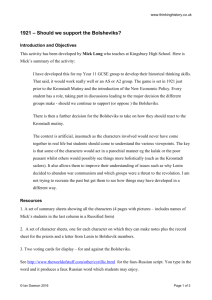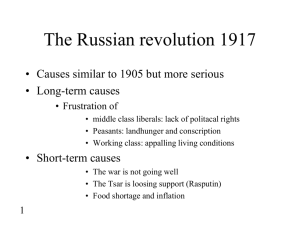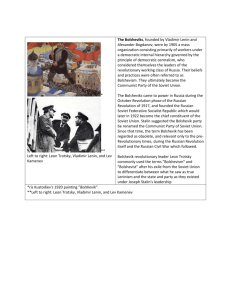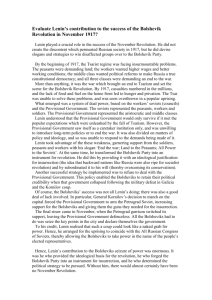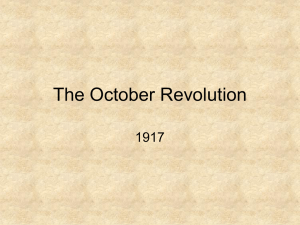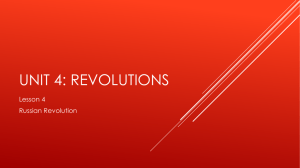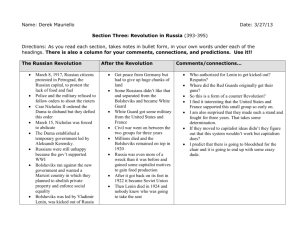Unit 2: The Revolution and Civil War (1917-1921)
advertisement
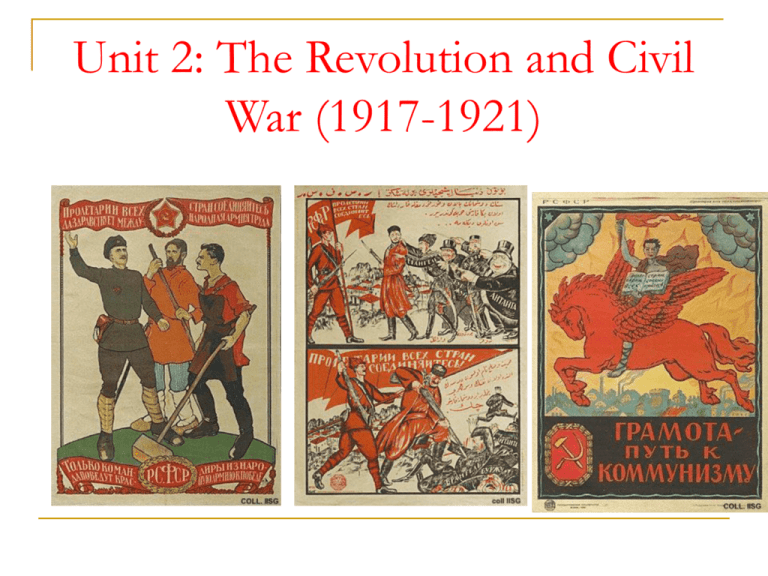
Unit 2: The Revolution and Civil War (1917-1921) The February Revolution Causes: 1. Food, coal shortages - led to strikes, riots 2. War effort - suffered 7 million casualties - poorly equipped soldiers - did well on the Caucasus Front vs. Turks and the Austrians on the Western Front but poorly against the Germans 3. Influence of Rasputin 4. Czarina Alexandra - German The February Revolution • March 8, 1917 – Riots broke out in Petrograd - Troops refused to fire on demonstrators. Many joined the protesters. - Nicholas II was at the front. When he tried to return to Petrograd, his trained was blocked by railway workers. The February Revolution • March 17, 1917: Czar Nicholas II tries to pass the throne to his brother. He refused. Nicholas II abdicates. • Provisional Government replaces Romanovs and the Duma. - Soviet of Workers and Soldiers formed. - “Dual Power” The Provisional Government and the Allies • Russia’s allies from Europe and the United States welcomed the Provisional Government for its commitment to the war effort and its democratic pronouncements. From February to October: Factors that Led to the Bolshevik Revolution 1. Provisional Government established a “bourgeois republic” – March 1917 * all citizens equal under the law * freedom of speech, religion, press, assembly and legalized unions * secret police, Siberian exile, death penalty abolished * ethnic minorities received autonomy / Poland & Finland declared independence * promised nationwide elections for a “Constituent Assembly” From February to October: Factors that Led to the Bolshevik Revolution 2. Allies welcomed Russia’s “democracy.” Needed Russia in the war. 3. Provisional Government honored its military commitment to the Allies. * As a result, conditions in the country worsened. * Failed to address workers demands for better wages, less hours, protection against unemployment * Failed to enact land reforms – peasants began seizing land in the spring 1917. * Soldiers began mutinying and deserting their ranks * Elections for the Constituent Assembly took place Nov. 12, after Provisional Govt. was overthrown 4. April, 1917: Lenin returns to Russia / issues the “April Theses”: * bourgeois revolution achieved – socialist rev. next step * “Land, Bread and Peace.” * “All power to the soviets!” From February to October: Factors that Led to the Bolshevik Revolution 5. “The July Days” (July 16-18) * radicals, with some Bolshevik participation, tried to sieze power in Petrograd. * Although Lenin opposed the attempt, he was blamed and fled to Finland. * Provisional Government failed to eliminate its opponents. From February to October: Factors that Led to the Bolshevik Revolution 6. The “Kornilov Affair” (September 1917) * General Lev Kornilov wanted to restore law and order in the country, discipline in the military and abolish the soviets. * Did not want to reestablish the monarchy. * He sent troops loyal to Petrograd to defend the Provisional Government. * Radicals mobilized against “counterrevolution” * Bolsheviks freed from the jails and given weapons to defend Petrograd. They gain upper hand in the Petrograd Soviet. * Kornilov arrested. Will lead an anti-Bolshevik force in the Civil War. Will be killed in battle. From February to October: Factors that Led to the Bolshevik Revolution 7. Growing popularity of the Bolsheviks * Party membership in February 1917: 24,000 / 100,000 by May / 350,000 by October 1917 * Bolsheviks captured a majority in the Petrograd Soviet on September 13 and in the Moscow Soviet a week later. * While the First All-Russian Congress of Soviets, convened in the summer, had a majority of moderate socialists, by the time of the storming of the Winter Palace, the Second All-Russian Congress of Soviets found the Bolsheviks in the majority. * November 7 / October 25, 1917 – Bolshevik-led soldiers stormed the Winter Palace defended by young cadets from a military academy and a women’s battalion. The Bolsheviks were in power. Bolsheviks in Power • Lenin and the Bolsheviks ultimate goal was to create a communist society in the former Russian empire. But they came to power without a clear blueprint for ruling the country and building socialism or even a clear strategy for governing. • Lenin’s first two decrees as head of the country: 1. negotiate a “just and democratic peace” without annexations and indemnities that would end WWI 2. abolish all landlord property immediately and without compensation to distribute to peasants. Bolsheviks in Power • Elections for the Constituent Assembly took place on November 12 on the basis of universal male suffrage. The results: 36 million votes were cast: 707 Total members 21 million – Socialist Revolutionaries – 61% / 370 members 40 Left SR’s 9 million - Bolsheviks - 25% / 170 members 6 million - all other parties - 14% / 34 Mensheviks about 100 other • • Constituent Assembly met on January 18, 1918. Lenin denounced it as a “bourgeois institution” that didn’t accurately represent the working masses and had it disbanded. • Workers agreed that Soviet power was more representative. No opposition to Bolshevik disbanding of the Constituent Assembly. • Bolsheviks were joined by the Left SR’s. Bolsheviks in Power • March, 1918 – Treaty of Brest-Litovsk - Lenin wanted out of the war at all costs. - Germans proposed Draconian conditions for peace. - Leon Trotsky, Soviet representative at the peace talks, opposed harsh German ultimatums. - During the talks, German army advanced deeper into Ukraine. • The terms: - Ukraine, Poland, Finland, Lithuania, Latvia, Estonia gained independence. Soviet Russia lost: - 26% of its total population. - 27% of its arable land - 32% of its average crop production - 26% of its railway system - 73% of its iron industries - 75% of its coal fields - forced to pay Germany a large indemnity. Bolsheviks in Power * As a result of Brest-Litovsk, Trotsky resigned as Commissar for Foreign Affairs. He was named Commander of the newly formed Red Army almost immediately. Bolsheviks in Power * As a result of Brest-Litovsk, the Left SR’s resigned from the government, turning Soviet Russia into a one partydictatorship until 1991. Pre-Civil War Bolshevik Policies (November 1917 – June 1918) 1. Peasant were given complete local control over the use of land through local peasant Soviets. 2. Workers control was introduced in all industrial, commercial and agricultural enterprises. Control would be exercised through factory committees and workers Soviets. - Banks and large factories were nationalized. - Foreign trade was monopolized by the state. 3. Judicial system was abolished – replaced by elected revolutionary tribunals and “people’s courts.” - December 1917 – CHEKA was founded and headed by Felix Dzerzhinsky. Precursor to the KGB. 4. National minorities were told they had the right to independence from Russia. 5. Titles and ranks were abolished. 6. Upper and middle classes had their property confiscated or divided. 7. Russian Orthodox Church property was confiscated and religious instruction in schools terminated. - Marx: “religion is the opiate of the masses.” Felix Edmundovich Dzerzhinsky “Iron Felix” (1877-1926) • • Born in Poland. Founder of the CHEKA. • it is estimated that at least half a million people were executed by Dzerzhinsky's agents between 1917-1926. • Dzerzhinsky also set up the first Soviet labour camps, later to become known as the gulags, on the remote Solovetsky Islands south of the Arctic Circle • Members of the secret police "should have a cool head, a warm heart and clean hands". • He was also known for helping a huge number of orphans and homeless people who appeared after the Bolshevik Revolution and Russian Civil War. Dzerzhinsky and the “Red Terror” “Proletarian coercion in all its forms, beginning with executions, is a method of delivering a communist man out of the material of a capitalist epoch.” - Dzerzhinsky The Civil War and “War Communism” (1918-1921) • The Civil War began in the summer of 1918 in response to Bolshevik policies. • The opposition to the Bolsheviks was known as the “White” movement. Consisted of: - the far Right (Monarchists, Russian nationalists, Cossacks, army officers) - centrists and liberals (bourgeois CADETS, Octobrists - Socialists (Mensheviks, SR’s) - Anarchists - Foreign Intervention (14 foreign armies intervened and supported the Whites vs. the Reds including 7,000 U.S. troops • The White armies did well in the beginning: - Execution of the Romanov family in Ekaterinburg July, 1918. Kronstadt Rebellion, March 1921 • An unsuccessful uprising of pro-Soviet sailors from Kronstadt against Bolshevik rule. • Led by Stepan Petrichenko. Included sailors from the ships Petropavlovsk and Sevastopol. • Grievances: 1. Bolshevik authoritarianism 2. Worsening condition of working class 3. Forced grain requisitioning / violence against the peasants 4. lack of freedom for other left-wing socialist forces. • The sailors of Kronstadt were the most radical and the biggest supporters of the Bolsheviks during the lead up until the October Revolution. Kronstadt Rebellion, 1921 Demands of the Kronstadt Sailors (part 1) Immediate new elections to the Soviets. The present Soviets no longer express the wishes of the workers and peasants. The new elections should be by secret ballot, and should be preceded by free electoral propaganda. Freedom of speech and of the press for workers and peasants, for the Anarchists, and for the Left Socialist parties. The right of assembly, and freedom for trade union and peasant organisations. The organisation, at the latest on 10th March 1921, of a Conference of non-Party workers, soldiers and sailors of Petrograd, Kronstadt and the Petrograd District. The liberation of all political prisoners of the Socialist parties, and of all imprisoned workers and peasants, soldiers and sailors belonging to working class and peasant organisations. The election of a commission to look into the dossiers of all those detained in prisons and concentration camps. Kronstadt Rebellion, March 1921 • Lenin ordered 50,000 Red Army troops under the command of Mikhail Tukhachevsky to crush the rebellion. • Many Red Army units were forced at gun point to attack the Kronstadt fortress. - Some joined the rebels. • 10 days after the assault and 10,000 casualties later, the Red Army entered the fortress. Tambov Rebellion 1919-1921 • Largest peasant rebellion against the Bolsheviks during the Civil War. • Led by Social Revolutionaries in response to forced grain requisitioning. • Mikhail Tukhachevsky was commander of Red Army forces (30,000) sent to crush the rebellion. • Future World War II hero Georgiy Zhukov earned his first medal fighting for the Red Army. Impact of the Tambov and Kronstadt Rebellions Forced Lenin to retreat from War Communism and implement the more moderate New Economic Policy (NEP) Soviet Russia at War vs. Poland (19191921) • Poles attacked to recuperate territory lost during the 3 partitions in the 18th C. • Soviets tried to spread communist revolution West. • Polish leader Josef Pilsudski felt White Russian Army a bigger threat than the Bolsheviks: - Bolsheviks denounced partitions of Poland and allowed Polish independence / White Russians wanted Poland back in Russian Empire - Let Bolsheviks off the hook when they were fighting against Whites in east and Poles in West. • Red Army forces under Mikhail Tukhachevsky made it all the way to Warsaw. • Polish counteroffensive led to the Poles occupying half of Belarus and Ukraine. Threat of Riga (1921) officially ended hostilities between the two. Soviet Russia at War vs. Poland (19191921): Propaganda Posters Soviet Russia at War vs. Poland (19191921): Propaganda Posters Soviet Russia at War vs. Poland (19191921): Main Commanders Mikhail Tukhachevsky Jozef Pilsudski Polish – Soviet Border Established by the Treaty of Riga (1921)

